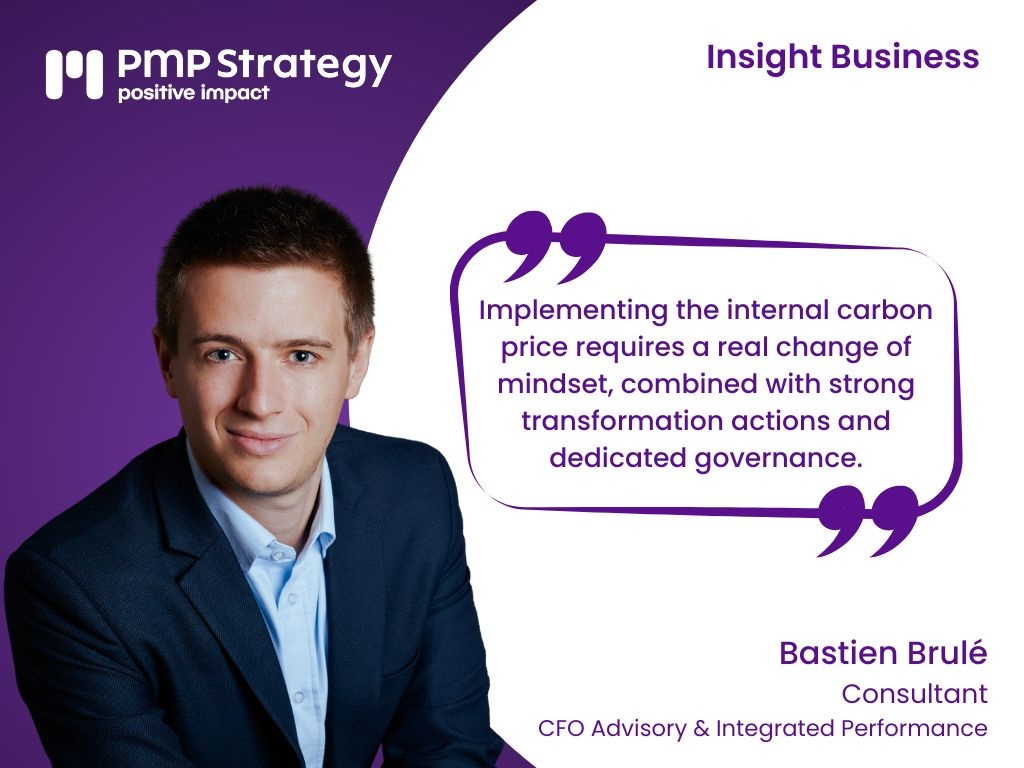Managing the carbon trajectory is one of the fundamental elements of global performance management.
One of the main tools used to accelerate its management is the internal carbon price, explains Bastien Brulé. Implementing this tool requires a real change of mindset, combined with strong transformation actions and dedicated governance.
The evolution of legislative frameworks and changes in consumer behavior regarding ecology requires companies to set increasingly binding decarbonization objectives. To set these reduction targets, companies need to understand the breakdown of their carbon footprint by the scope and define indicators to monitor such as carbon emissions in absolute value (tons of CO2 emitted), carbon intensity (kg CO2 / € EBITDA), or the internal price of carbon (in € per ton of CO2).
What objectives are we trying to achieve with an internal carbon price?
The implementation of an internal carbon price makes it possible to anticipate the management of climate risk and its impact on external prices (taxes or market prices for the sectors concerned by the EU ETS) as well as to objectify the decarbonization ambitions set by the company.
Moreover, by accelerating low-carbon investments and promoting the associated solutions within their value chain, companies can reduce their cost of capital by accessing new tools dedicated to subsidized rates (e.g., Green Bonds, etc.). Finally, improving their energy efficiency is an essential component of sustainable economic profitability in many sectors, particularly in the current inflationary context.
The implementation of an internal carbon price requires a review of its basic geometry. Indeed, it must respond to 3 dimensions:
The price level (or height) must be set by considering either the market price or the social value of carbon. Once the price calculation indicator has been set, several price levels can be established, notably according to geography or type of decision/activity.
The scope of the emissions covered (or width) makes it possible to understand the scope of application of the internal carbon price (scope 1, 2, or even 3) and thus, for scope 3, to question the alignment of carbon pricing with customer decisions as well as the “purchasing framework agreements” with suppliers.
The influence of the internal carbon price (or depth) makes it possible to define whether the internal carbon price is intended to strongly influence decision-making or to have a purely indicative role. In order to be as important as financial indicators, the internal carbon price must be driven at a high level of management and be widely disseminated within the company.
Current practices in companies:
It is estimated today that 20% to 30% of large companies have implemented an internal carbon price within their organization. This percentage is increasing, and many groups are looking to integrate it into their decision-making process systematically.
The first objective cited by a panel of French companies interviewed by our firm is to ensure the alignment of the company’s investments (CAPEX and R&D) with its CO2 emission reduction objectives thus promoting low-carbon solutions that would not have been deemed profitable early on without internal carbon pricing.
This desire to transform results from the need to anticipate changes in external prices (taxes or market prices) and climate risk management.
To achieve their reduction targets, companies are including the management of their carbon footprint in their decision-making bodies and traditional management cycles (investment committees and business reviews) by adding their own analysis and monitoring changes in their carbon footprint (scope 1, 2 and 3) using dedicated limited indicators. Some companies even go so far as to change the variable compensation components for managers by linking them to dedicated action plans.
Internal prices are generally set, within the framework of dedicated governance, by a committee of internal and external experts based on the recommendations from scientists. Most companies that have implemented an internal carbon price also consider various time horizons in order to define increasing price trajectories.
These approaches are often supported by the strategy and finance departments, and are part of the risk management strategy, enabling some large international groups to anticipate legislative changes in certain geographical areas.
Finally, it is important to remember that an internal carbon price is not an end in itself.
According to the Task Force on Climate-related Financial Disclosures (TCFD), the internal price of carbon is not enough to ensure an organization’s transition to a carbon-neutral model. The internal carbon price is only one among a range of tools available to companies. Other management tools exist, such as the carbon budget. It is generally used by large groups and corresponds to the maximum level of CO2 that can still theoretically be emitted by a BU or a zone in line with the objectives of the SBTi trajectory of the concerned groups.






